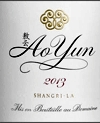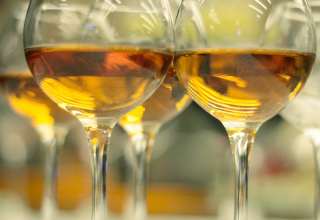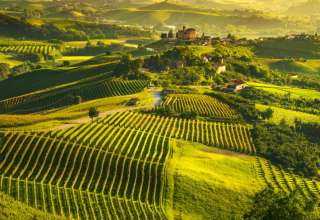Chinese wines are getting better and better – and more extreme. The latest and priciest is Ao Yun, grown at a lung-punishing 2,600m. Roger Morris explores
With assistance from one of France’s most-respected wine brands, China has produced its first high-profile luxury wine, one that may even be targeted by that country’s legendary cadre of wine counterfeiters.
The wine’s name is Ao Yun and it costs about $300 per bottle in European and American markets. It comes from Cabernet Sauvignon vineyards grown at 2,600m in the Himalayan foothills near the where the legendary city of Shangri-La was said to exist along the headwaters of the Mekong River in Yunan Province. Need more? The producer is none other than Möet Hennessey, which oversees the 300 hectares of small vineyard plots planted in 2002at the direction of the Chinese government.
Early tasters of the wine launched this year claim it has similarities to those made in Napa Valley, Bierzo, Languedoc and – yes – Bordeaux.
Ao Yun and a handful of early export wines – mostly red blends and ice wines – may flip the wine trade’s attention from how well top wines from the West are selling in China to how well Chinese quality wines are selling in the West. The globe-trotting wine consultant Michel Rolland was once asked about a winery project he was consulting in India, and he replied that there was great terroir potential in many Asian locales that had not previously produced commercial wines. The real problem, he said, was lack of infrastructure – companies that could lend technical support in the vineyards and in the wineries – and China now seems to be overcoming that.
Although wine grapes are grown in many parts of the country, two-thirds come from five regions – Xinjiang, Hebei, Shandong, Lioaning and Henan. One high-profile winery, Château Hansen, is located in a coal mining region on the edge of the Gobi Desert in Inner Mongolia. As one might expect, soil types are varied over such a vast range of territories, but common factors are good drainage and plenty of sunlight. Although China trails only Italy in total vineyard planted, with about 800,000 hectares, much of this goes to table grapes. Actual wine production is a rather modest 1.2 million hectoliters.
China has been commercially producing small amounts of grape wines since Changyu Winery opened its doors in 1892 at Yantai. Along with Chardonnay, Bordeaux red and white grapes have been most popular varieties planted. One of these, Carménère, is locally called Cabernet Gernischt and is almost considered to be indigenous. Surprisingly, ice wine made from the hybrid grape Vidal, the same varietal used to make most Canadian ice wine, has received good reviews.
But it has been only in recent decades that investment and winemaking knowhow have begun to pour in from the West. Rémy Cointreau established Dynasty Wines in 1980. LMVH’s Chandon division has been producing sparkling wines since 2013. Château Rongzi hired former Pétrus winemaker Jean-Claude Berrouet to produce its reds, while Château Hansen brought in French sommelier and marketing innovator Bruno Paumard to help gain a worldwide presence.
The export market has been slow to take off, and many top wines in competitions in China are still not available outside the country. Fortunately, many of those that are exported are widely available through retailers with established online sales, including those listed below. Here are five top wines, including an affordable supermarket entry, worth seeking out:

- Ao Yun 2013. (About $300, available through major British and American retailers.) Its name means “above the clouds,” which could refer to its high-altitude sourcing or its introductory price. Ao Yun is a big, fruity, tannic wine in the Robert Parker tradition, and there were 24,000 bottles made, and that production should increase. When looking to establish its presence in China, LMVH searched several different areas before settling on Yunan province, where the vines are tended by local farmers on both banks of the Mekong. The blend is 90% Cabernet Sauvignon and 10% Cabernet Franc.
 Grace Vineyard Chairman’s Reserve 2010. (₤45per bottle at Seckford Wines in Suffolk). In 1997, the Chang family, which has significant holding in local coal mines, retained French enologist Denis Boubals to select a site in Shanxi to make Bordeaux-style wine. He planted Grace Vineyard on well-drained soils, in the Bordeaux tradition. Chairman’s Reserve is its premium red blend, one that exhibits spicy, savory and earthy flavors.
Grace Vineyard Chairman’s Reserve 2010. (₤45per bottle at Seckford Wines in Suffolk). In 1997, the Chang family, which has significant holding in local coal mines, retained French enologist Denis Boubals to select a site in Shanxi to make Bordeaux-style wine. He planted Grace Vineyard on well-drained soils, in the Bordeaux tradition. Chairman’s Reserve is its premium red blend, one that exhibits spicy, savory and earthy flavors.
- Château Rongzi Cabernet Sauvignon Black Label 2012. ($129 at Royal Comfort Distributors in Oregon.) The vineyards are located at 1300 meters level along the Yellow River Valley in the Shanxi Lvliang Mountains on a plateau that features deep loess soils. Ex-Pétrus winemaker Berrouet has the grapes hand-picked and manually sorted and, after fermentation, ages the wine for one year in oak barrels. The result is an elegant, mellow wine that is ready for drinking but also well-balanced for aging.
![]()
- Silver Heights Family Reserve Red 2013. (About $46 via the Flying Winemaker and Watson’s Wine in Hong Kong.) The French are not the only ones to invest in Hong Kong. Spain’s Torres family established Torres China 20 years ago, also in the mountains of Ningxia, where the vineyards have plenty of sun and rocky soils to force the roots to go deep. Silver Heights is headed by one of the few women winemakers in China, Emma Gao, who holds a Diplôme National d’Oenologue and interned at Château Calon-Ségur and Château Lafon-Rochet.
- Changyu Moser XV Cabernet Sauvignon 2015. (₤7 at Tesco.) Increasingly, Chinese wines are finding their way into supermarkets, with Changyu Moser being one of the largest selections. This Cabernet from the warm, dry soils of Helen Mountains of Ningxia is touted by retailers as being a “cross between classic Bordeaux and a rich, fruity Australia wine.” Austrian Lenz Moser is consulting winemaker.







